Blogs
Causes of Flat Feet
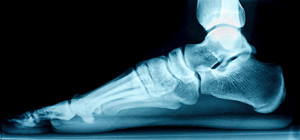 Flat feet, also known as fallen arches, is a common condition in infants, and typically disappears by age three as the foot grows. In adults, this condition can be caused by illness or injury. Being overweight can also be a contributing factor. Therefore, a change in diet may help alleviate symptoms of the condition. Sometimes flat feet are caused by a short Achilles tendon, resulting in pain. A rare cause can be if bones become fused together. When the tendon that connects the inside of the ankle to the calf muscle is injured, flat feet may occur. While flat feet are common, it is a good idea to consult with a podiatrist to avoid any potential complications.
Flat feet, also known as fallen arches, is a common condition in infants, and typically disappears by age three as the foot grows. In adults, this condition can be caused by illness or injury. Being overweight can also be a contributing factor. Therefore, a change in diet may help alleviate symptoms of the condition. Sometimes flat feet are caused by a short Achilles tendon, resulting in pain. A rare cause can be if bones become fused together. When the tendon that connects the inside of the ankle to the calf muscle is injured, flat feet may occur. While flat feet are common, it is a good idea to consult with a podiatrist to avoid any potential complications.
Flatfoot is a condition many people suffer from. If you have flat feet, contact Dr. Dean D. Hinners from Illinois. Our doctor will treat your foot and ankle needs.
What Are Flat Feet?
Flatfoot is a condition in which the arch of the foot is depressed and the sole of the foot is almost completely in contact with the ground. About 20-30% of the population generally has flat feet because their arches never formed during growth.
Conditions & Problems:
Having flat feet makes it difficult to run or walk because of the stress placed on the ankles.
Alignment – The general alignment of your legs can be disrupted, because the ankles move inward which can cause major discomfort.
Knees – If you have complications with your knees, flat feet can be a contributor to arthritis in that area.
Symptoms
- Pain around the heel or arch area
- Trouble standing on the tip toe
- Swelling around the inside of the ankle
- Flat look to one or both feet
- Having your shoes feel uneven when worn
Treatment
If you are experiencing pain and stress on the foot you may weaken the posterior tibial tendon, which runs around the inside of the ankle.
If you have any questions please feel free to contact one of our offices located in Metropolis and Eldorado, IL . We offer the newest diagnostic and treatment technologies for all your foot and ankle needs.
Where Did This Foot Blister Come From?
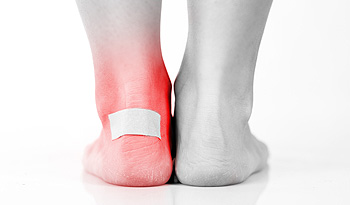 Blisters are small, fluid-filled bumps on the skin that form in response to trauma. The most common cause of blisters on the feet are shoes rubbing repeatedly against the skin. However, there are a variety of other reasons you may have developed a blister. These can include burns or sunburns, frostbite, eczema, allergic reactions, exposure to poison ivy, viruses that cause chicken pox or cold sores, and various diseases or infections. If you have a foot blister and can’t pinpoint the cause, or if your blister is draining pus, red in color, warm or painful, or if you have a fever, diabetes, or circulatory problems, it is strongly recommended that you visit a podiatrist. A podiatrist can examine and treat blisters on the feet and provide the appropriate treatment.
Blisters are small, fluid-filled bumps on the skin that form in response to trauma. The most common cause of blisters on the feet are shoes rubbing repeatedly against the skin. However, there are a variety of other reasons you may have developed a blister. These can include burns or sunburns, frostbite, eczema, allergic reactions, exposure to poison ivy, viruses that cause chicken pox or cold sores, and various diseases or infections. If you have a foot blister and can’t pinpoint the cause, or if your blister is draining pus, red in color, warm or painful, or if you have a fever, diabetes, or circulatory problems, it is strongly recommended that you visit a podiatrist. A podiatrist can examine and treat blisters on the feet and provide the appropriate treatment.
Blisters are prone to making everyday activities extremely uncomfortable. If your feet are hurting, contact Dr. Dean D. Hinners of Illinois. Our doctor can provide the care you need to keep you pain-free and on your feet.
Foot Blisters
Foot blisters develop as a result of constantly wearing tight or ill-fitting footwear. This happens due to the constant rubbing from the shoe, which can often lead to pain.
What Are Foot Blisters?
A foot blister is a small fluid-filled pocket that forms on the upper-most layer of the skin. Blisters are filled with clear fluid and can lead to blood drainage or pus if the area becomes infected.
How Do Blisters Form?
Blisters on the feet are often the result of constant friction of skin and material, usually by shoe rubbing. Walking in sandals, boots, or shoes that don’t fit properly for long periods of time can result in a blister. Having consistent foot moisture and humidity can easily lead to blister formation.
Prevention & Treatment
It is important to properly care for the affected area in order to prevent infection and ease the pain. Do not lance the blister and use a Band-Aid to provide pain relief. Also, be sure to keep your feet dry and wear proper fitting shoes. If you see blood or pus in a blister, seek assistance from a podiatrist.
If you have any questions, please feel free to contact one of our offices located in Metropolis and Eldorado, IL . We offer the newest diagnostic and treatment technologies for all your foot care needs.
How Can Diabetes Affect the Feet?
 Patients who are diabetic are often concerned about how this condition can affect their feet. It is common to develop neuropathy, which can cause a loss of feeling in the feet. This can lead to the inability to feel bruises, cuts, or wounds on the feet. It may cause an infection, and if it is not promptly and properly treated, this may result in toe or foot amputation. Diabetes occurs when the blood sugar levels in the blood become elevated, but it can potentially be controlled by implementing healthy lifestyle changes. These can include eating fresh fruits and vegetables, and refraining from eating foods and drinks that have a high sugar content. It is beneficial to perform a daily foot check, as this is helpful in noticing any cuts that may have developed. If you have diabetes, it is strongly suggested that you are under the care of a podiatrist who can help you to manage this condition.
Patients who are diabetic are often concerned about how this condition can affect their feet. It is common to develop neuropathy, which can cause a loss of feeling in the feet. This can lead to the inability to feel bruises, cuts, or wounds on the feet. It may cause an infection, and if it is not promptly and properly treated, this may result in toe or foot amputation. Diabetes occurs when the blood sugar levels in the blood become elevated, but it can potentially be controlled by implementing healthy lifestyle changes. These can include eating fresh fruits and vegetables, and refraining from eating foods and drinks that have a high sugar content. It is beneficial to perform a daily foot check, as this is helpful in noticing any cuts that may have developed. If you have diabetes, it is strongly suggested that you are under the care of a podiatrist who can help you to manage this condition.
Diabetic foot care is important in preventing foot ailments such as ulcers. If you are suffering from diabetes or have any other concerns about your feet, contact Dr. Dean D. Hinners from Illinois. Our doctor can provide the care you need to keep you pain-free and on your feet.
Diabetic Foot Care
Diabetes affects millions of people every year. The condition can damage blood vessels in many parts of the body, especially the feet. Because of this, taking care of your feet is essential if you have diabetes, and having a podiatrist help monitor your foot health is highly recommended.
The Importance of Caring for Your Feet
- Routinely inspect your feet for bruises or sores.
- Wear socks that fit your feet comfortably.
- Wear comfortable shoes that provide adequate support.
Patients with diabetes should have their doctor monitor their blood levels, as blood sugar levels play such a huge role in diabetic care. Monitoring these levels on a regular basis is highly advised.
It is always best to inform your healthcare professional of any concerns you may have regarding your feet, especially for diabetic patients. Early treatment and routine foot examinations are keys to maintaining proper health, especially because severe complications can arise if proper treatment is not applied.
If you have any questions please feel free to contact one of our offices located in Metropolis and Eldorado, IL . We offer the newest diagnostic and treatment technologies for all your foot and ankle needs.
Prevention of an Achilles Tendon Injury

Tendons connect muscles to bones. The Achilles tendon, the largest and strongest tendon in the body, connects the lower part of the calf muscles to the heel bone. This tendon helps the calf muscle in pointing the toe or doing a calf raise, and aids in all movement of the ankle joint. When it is overworked or inflexible, it is at risk for injury. Damage to the Achilles tendon can include strain, rupture, or tendinitis. The most common injury to this tendon is tendinitis. This can happen when the tendon is stressed from repetitive movements like running or jumping, or from a change in an athlete’s training program. Additionally, it may happen as a result of training at a level the body cannot handle, or from having inflexible calf muscles. Achilles tendon injuries can be prevented with frequent lower leg stretches, strengthening the calf muscles and Achilles tendon, and engaging in appropriate training for a sport. Shorter, easier workouts should gradually progress to becoming longer, and more difficult. Decreasing the activity that caused pain, and resting are the first things one should do if they have injured their Achilles tendon. If you have pain in your Achilles tendon that continues or worsens, it is suggested that you consult with a podiatrist for a proper diagnosis and treatment plan.
Achilles tendon injuries need immediate attention to avoid future complications. If you have any concerns, contact Dr. Dean D. Hinners of Illinois. Our doctor can provide the care you need to keep you pain-free and on your feet.
What Is the Achilles Tendon?
The Achilles tendon is a tendon that connects the lower leg muscles and calf to the heel of the foot. It is the strongest tendon in the human body and is essential for making movement possible. Because this tendon is such an integral part of the body, any injuries to it can create immense difficulties and should immediately be presented to a doctor.
What Are the Symptoms of an Achilles Tendon Injury?
There are various types of injuries that can affect the Achilles tendon. The two most common injuries are Achilles tendinitis and ruptures of the tendon.
Achilles Tendinitis Symptoms
- Inflammation
- Dull to severe pain
- Increased blood flow to the tendon
- Thickening of the tendon
Rupture Symptoms
- Extreme pain and swelling in the foot
- Total immobility
Treatment and Prevention
Achilles tendon injuries are diagnosed by a thorough physical evaluation, which can include an MRI. Treatment involves rest, physical therapy, and in some cases, surgery. However, various preventative measures can be taken to avoid these injuries, such as:
- Thorough stretching of the tendon before and after exercise
- Strengthening exercises like calf raises, squats, leg curls, leg extensions, leg raises, lunges, and leg presses
If you have any questions please feel free to contact one of our offices located in Metropolis and Eldorado, IL . We offer the newest diagnostic tools and technology to treat your foot and ankle needs.
Are Bunions Affecting Your Everyday Life?
Facts About Charcot-Marie-Tooth Disease

A neurological disorder that causes weakness and loss of feeling in the feet, Charcot-Marie-Tooth disease, is named after the three doctors who first identified the condition in 1886. It is an inherited disease for which there is no cure and is believed to affect one in every 2,500 people. Symptoms include weakness and lack of sensation in the feet that can progress into a deformity in the arch of the foot. It also may cause curled toes, pain, cramps, and difficulty walking. Charcot-Marie-Tooth disease also can spread to other areas of the body including the legs, hands, and arms. Treatment options include therapy, orthotics, surgery, and medication. Sometimes ankle braces and foot orthotics are prescribed as well as strengthening and stretching exercises. If you have symptoms of Charcot-Marie-Tooth disease it is suggested that you consult with a podiatrist for an exam, diagnosis, and treatment plan best suited for you.
Neuropathy
Neuropathy can be a potentially serious condition, especially if it is left undiagnosed. If you have any concerns that you may be experiencing nerve loss in your feet, consult with Dr. Dean D. Hinners from Illinois. Our doctor will assess your condition and provide you with quality foot and ankle treatment for neuropathy.
What Is Neuropathy?
Neuropathy is a condition that leads to damage to the nerves in the body. Peripheral neuropathy, or neuropathy that affects your peripheral nervous system, usually occurs in the feet. Neuropathy can be triggered by a number of different causes. Such causes include diabetes, infections, cancers, disorders, and toxic substances.
Symptoms of Neuropathy Include:
- Numbness
- Sensation loss
- Prickling and tingling sensations
- Throbbing, freezing, burning pains
- Muscle weakness
Those with diabetes are at serious risk due to being unable to feel an ulcer on their feet. Diabetics usually also suffer from poor blood circulation. This can lead to the wound not healing, infections occurring, and the limb may have to be amputated.
Treatment
To treat neuropathy in the foot, podiatrists will first diagnose the cause of the neuropathy. Figuring out the underlying cause of the neuropathy will allow the podiatrist to prescribe the best treatment, whether it be caused by diabetes, toxic substance exposure, infection, etc. If the nerve has not died, then it’s possible that sensation may be able to return to the foot.
Pain medication may be issued for pain. Electrical nerve stimulation can be used to stimulate nerves. If the neuropathy is caused from pressure on the nerves, then surgery may be necessary.
If you have any questions, please feel free to contact one of our offices located in Metropolis and Eldorado, IL . We offer the newest diagnostic and treatment technologies for all your foot care needs.
Flat Feet May Gradually Disappear with Age
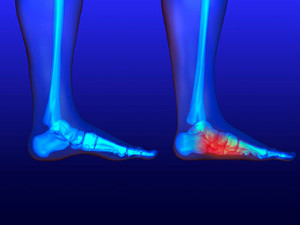 The medical term that is referred to as flat feet is indicative of the arches in the foot appearing lower than what is classified as normal. Most babies are born with flat feet, and the arches will gradually develop as the aging process occurs. Some patients will have flat feet, or fallen arches throughout their lives, and this may be a result of improper development of the arches during childhood. Noticeable symptoms of this condition may be discomfort and pain in the area where the arch should be, in addition to possible heel pain. Patients whose arches have not properly developed may experience frequent falling or tripping or may notice considerable weakness or pain in the feet. Research has indicated that wearing shoes, which are more supportive may aid in living with flat feet, in addition to performing gentle stretches, which may improve overall flexibility of the foot. If you have this condition, it is important to consult with a podiatrist, who can properly guide you to implement correct treatment techniques.
The medical term that is referred to as flat feet is indicative of the arches in the foot appearing lower than what is classified as normal. Most babies are born with flat feet, and the arches will gradually develop as the aging process occurs. Some patients will have flat feet, or fallen arches throughout their lives, and this may be a result of improper development of the arches during childhood. Noticeable symptoms of this condition may be discomfort and pain in the area where the arch should be, in addition to possible heel pain. Patients whose arches have not properly developed may experience frequent falling or tripping or may notice considerable weakness or pain in the feet. Research has indicated that wearing shoes, which are more supportive may aid in living with flat feet, in addition to performing gentle stretches, which may improve overall flexibility of the foot. If you have this condition, it is important to consult with a podiatrist, who can properly guide you to implement correct treatment techniques.
Flatfoot is a condition many people suffer from. If you have flat feet, contact Dr. Dean D. Hinners from Illinois. Our doctor will treat your foot and ankle needs.
What Are Flat Feet?
Flatfoot is a condition in which the arch of the foot is depressed and the sole of the foot is almost completely in contact with the ground. About 20-30% of the population generally has flat feet because their arches never formed during growth.
Conditions & Problems:
Having flat feet makes it difficult to run or walk because of the stress placed on the ankles.
Alignment – The general alignment of your legs can be disrupted, because the ankles move inward which can cause major discomfort.
Knees – If you have complications with your knees, flat feet can be a contributor to arthritis in that area.
Symptoms
- Pain around the heel or arch area
- Trouble standing on the tip toe
- Swelling around the inside of the ankle
- Flat look to one or both feet
- Having your shoes feel uneven when worn
Treatment
If you are experiencing pain and stress on the foot you may weaken the posterior tibial tendon, which runs around the inside of the ankle.
If you have any questions please feel free to contact one of our offices located in Metropolis and Eldorado, IL . We offer the newest diagnostic and treatment technologies for all your foot and ankle needs.
What Are the Symptoms of Toenail Fungus?
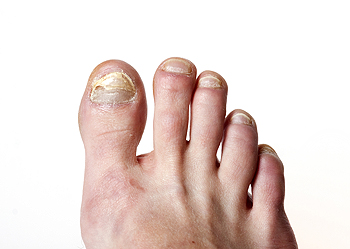 Patients who have experienced toenail fungus typically find it may take a long time to treat. Common symptoms of this type of fungus often include a yellowing and thickening of the toenails, and they can crack as a result of becoming brittle. Toenail fungus may develop if the toes are frequently in a warm and moist environment, which can include hot and sweaty shoes. Additionally, it may be present in public pools, shower room floors, and surrounding areas. There are methods that can be implemented which may help to prevent this condition from developing. These can consist of wearing appropriate shoes while in public areas, keeping the feet clean and dry, and wearing clean socks daily. If you believe you have symptoms of toenail fungus, it is advised that you seek the counsel of a podiatrist who can guide you towards the proper treatment.
Patients who have experienced toenail fungus typically find it may take a long time to treat. Common symptoms of this type of fungus often include a yellowing and thickening of the toenails, and they can crack as a result of becoming brittle. Toenail fungus may develop if the toes are frequently in a warm and moist environment, which can include hot and sweaty shoes. Additionally, it may be present in public pools, shower room floors, and surrounding areas. There are methods that can be implemented which may help to prevent this condition from developing. These can consist of wearing appropriate shoes while in public areas, keeping the feet clean and dry, and wearing clean socks daily. If you believe you have symptoms of toenail fungus, it is advised that you seek the counsel of a podiatrist who can guide you towards the proper treatment.
For more information about treatment, contact Dr. Dean D. Hinners of Illinois. Our doctor can provide the care you need to keep you pain-free and on your feet.
Toenail Fungus Treatment
Toenail fungus is a condition that affects many people and can be especially hard to get rid of. Fortunately, there are several methods to go about treating and avoiding it.
Antifungals & Deterrence
Oral antifungal medicine has been shown to be effective in many cases. It is important to consult with a podiatrist to determine the proper regiment for you, or potentially explore other options.
Applying foot powder on the feet and shoes helps keep the feet free of moisture and sweat.
Sandals or open toed shoes – Wearing these will allow air movement and help keep feet dry. They also expose your feet to light, which fungus cannot tolerate. Socks with moisture wicking material also help as well.
If you have any questions please feel free to contact one of our offices located in Metropolis and Eldorado, IL . We offer the newest diagnostic tools and technology to treat your foot and ankle needs.
Types of Corns and Calluses
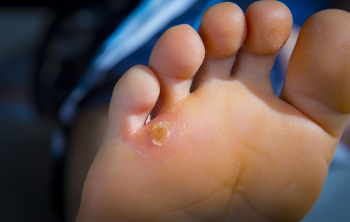 When walking or standing for long periods of time, certain areas of the skin on the feet thicken to help withstand pressure. These areas of thickness are either corns or calluses that work as a protective measure when the skin rubs on the bone, shoe or the ground. Calluses are larger, more irregularly shaped areas of hardened skin on the foot that usually indicate an issue such as a bone deformity, poor walking style, or poor footwear. Corns are much smaller and have a central core. There are five main types of corns that can develop on the feet. Hard corns are concentrated to the size of a pea, and soft corns develop similarly and usually appear when the skin is moist from sweat or in between the toes. A seed corn is very tiny and can occur by itself or as a cluster. Vascular corns contain nerve fibers and blood vessels and are very painful. Fibrous corns attach to deeper tissues and tend to last a long time on the foot. If you have a corn or callus that is irritating your foot, consulting with a podiatrist is suggested.
When walking or standing for long periods of time, certain areas of the skin on the feet thicken to help withstand pressure. These areas of thickness are either corns or calluses that work as a protective measure when the skin rubs on the bone, shoe or the ground. Calluses are larger, more irregularly shaped areas of hardened skin on the foot that usually indicate an issue such as a bone deformity, poor walking style, or poor footwear. Corns are much smaller and have a central core. There are five main types of corns that can develop on the feet. Hard corns are concentrated to the size of a pea, and soft corns develop similarly and usually appear when the skin is moist from sweat or in between the toes. A seed corn is very tiny and can occur by itself or as a cluster. Vascular corns contain nerve fibers and blood vessels and are very painful. Fibrous corns attach to deeper tissues and tend to last a long time on the foot. If you have a corn or callus that is irritating your foot, consulting with a podiatrist is suggested.
If you have any concerns regarding your feet and ankles, contact Dr. Dean D. Hinners of Illinois. Our doctor will treat your foot and ankle needs.
Corns: What Are They? and How Do You Get Rid of Them?
Corns can be described as areas of the skin that have thickened to the point of becoming painful or irritating. They are often layers and layers of the skin that have become dry and rough, and are normally smaller than calluses.
Ways to Prevent Corns
There are many ways to get rid of painful corns such as wearing:
- Well-fitting socks
- Comfortable shoes that are not tight around your foot
- Shoes that offer support
Treating Corns
Treatment of corns involves removing the dead skin that has built up in the specific area of the foot. Consult with Our doctor to determine the best treatment option for your case of corns.
If you have any questions please feel free to contact one of our offices located in Metropolis and Eldorado, IL . We offer the newest diagnostic and treatment technologies for all your foot and ankle needs.
The Relationship Between Gout and Alcohol

Gout is one of the many conditions that impacts the joints of the body. Specifically, when there is an excess of uric acid in the body, gout occurs commonly in the joint of the big toe. If an individual has gout, they may feel intense pain in the joints during what is known as “gout attacks.” Swelling and sensations of warmness may occur. Gout has an interesting relationship with alcohol that anyone who is serious about maintaining the health of their feet ought to be aware of. Consuming large quantities of alcohol can increase the risk of developing or aggravating gout in some individuals. This is because alcohol is a substance that contains many purines, and when the human body processes purines, uric acid is ultimately released. Uric acid, of course, causes gout. It is important to note that consuming beer, as opposed to hard liquor, makes one more susceptible to increasing the risk of developing gout. Additionally, men can be even more prone to developing gout from alcohol than women. If you are drinking more than twelve drinks of alcohol in any given week, then you may be putting yourself at risk of a gout attack in your feet. You might want to contact a podiatrist who will be able to help you treat or mitigate any problems related to gout.
Gout is a foot condition that requires certain treatment and care. If you are seeking treatment, contact Dr. Dean D. Hinners from Illinois. Our doctor will treat your foot and ankle needs.
What Is Gout?
Gout is a type of arthritis caused by a buildup of uric acid in the bloodstream. It often develops in the foot, especially the big toe area, although it can manifest in other parts of the body as well. Gout can make walking and standing very painful and is especially common in diabetics and the obese.
People typically get gout because of a poor diet. Genetic predisposition is also a factor. The children of parents who have had gout frequently have a chance of developing it themselves.
Gout can easily be identified by redness and inflammation of the big toe and the surrounding areas of the foot. Other symptoms include extreme fatigue, joint pain, and running high fevers. Sometimes corticosteroid drugs can be prescribed to treat gout, but the best way to combat this disease is to get more exercise and eat a better diet.
If you have any questions please feel free to contact one of our offices located in Metropolis and Eldorado, IL . We offer the newest diagnostic and treatment technologies for all your foot and ankle needs.
More...
Types of Foot Fractures
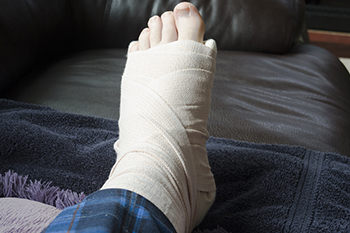
One of the most detrimental conditions to negatively impact the health of the feet is broken or fractured feet. An individual has a fracture of their feet when a bone breaks. If you have a fractured foot, you may experience pain in and around the feet. Your affected foot might even appear bruised, and it could be difficult for you to put weight on it. Generally speaking, there are two main types of broken feet. First, you can develop what is known as a full foot fracture. This condition is caused by some type of one-time injury. Commonly, individuals can develop a full foot fracture by dropping a significantly heavy object directly onto their foot. If you have a full foot injury, the various muscles and tissues that surround the foot might be injured or affected. However, this is not always the case with certain full foot injuries. Second, you can develop what is known as a stress fracture in the foot. This type of injury occurs over an extended period of time when a specific part of the foot undergoes repeated stress and overuse. These two types of foot fractures have different causes, yet they can share some of the same symptoms. If you believe that you may have broken or fractured your foot, you can seek guidance from a podiatrist who can help you identify and address the problem.
A broken foot requires immediate medical attention and treatment. If you need your feet checked, contact Dr. Dean D. Hinners from Illinois. Our doctor can provide the care you need to keep you pain-free and on your feet.
Broken Foot Causes, Symptoms, and Treatment
A broken foot is caused by one of the bones in the foot typically breaking when bended, crushed, or stretched beyond its natural capabilities. Usually the location of the fracture indicates how the break occurred, whether it was through an object, fall, or any other type of injury.
Common Symptoms of Broken Feet:
- Bruising
- Pain
- Redness
- Swelling
- Blue in color
- Numbness
- Cold
- Misshapen
- Cuts
- Deformities
Those that suspect they have a broken foot shoot seek urgent medical attention where a medical professional could diagnose the severity.
Treatment for broken bones varies depending on the cause, severity and location. Some will require the use of splints, casts or crutches while others could even involve surgery to repair the broken bones. Personal care includes the use of ice and keeping the foot stabilized and elevated.
If you have any questions please feel free to contact one of our offices located in Metropolis and Eldorado, IL . We offer the newest diagnostic and treatment technologies for all your foot and ankle needs.
What Is Plantar Hyperhidrosis
 Hyperhidrosis is the medical term for a condition that causes excessive sweating all over the body. Plantar hyperhidrosis is a form of this condition that specifically affects the feet. This ailment usually begins in childhood or adolescence, and in severe cases can cause some physical limitations. The extra moisture can make the feet more prone to bacterial or fungal infections and blisters. Tinea pedis and pitted keratolysis are two examples of possible infections that can result from excess moisture. These two infections can easily be treated with antifungal cream, antibiotic cream, or medication. Plantar hyperhidrosis is symmetric, so it affects both feet equally. The sweating can range from mild excessive sweating to severe constant sweating. If you think you may have plantar hyperhidrosis, then it is recommended you consult with a podiatrist to learn new methods to help living with this condition.
Hyperhidrosis is the medical term for a condition that causes excessive sweating all over the body. Plantar hyperhidrosis is a form of this condition that specifically affects the feet. This ailment usually begins in childhood or adolescence, and in severe cases can cause some physical limitations. The extra moisture can make the feet more prone to bacterial or fungal infections and blisters. Tinea pedis and pitted keratolysis are two examples of possible infections that can result from excess moisture. These two infections can easily be treated with antifungal cream, antibiotic cream, or medication. Plantar hyperhidrosis is symmetric, so it affects both feet equally. The sweating can range from mild excessive sweating to severe constant sweating. If you think you may have plantar hyperhidrosis, then it is recommended you consult with a podiatrist to learn new methods to help living with this condition.
If you are suffering from hyperhidrosis contact Dr. Dean D. Hinners of Illinois. Our doctor can provide the care you need to attend to all of your foot and ankle needs.
Hyperhidrosis of the Feet
Hyperhidrosis is a rare disorder that can cause people to have excessive sweating of their feet. This can usually occur all on its own without rigorous activity involved. People who suffer from hyperhidrosis may also experience sweaty palms.
Although it is said that sweating is a healthy process meant to cool down the body temperature and to maintain a proper internal temperature, hyperhidrosis may prove to be a huge hindrance on a person’s everyday life.
Plantar hyperhidrosis is considered to be the main form of hyperhidrosis. Secondary hyperhidrosis can refer to sweating that occurs in areas other than the feet or hands and armpits. Often this may be a sign of it being related to another medical condition such as menopause, hyperthyroidism and even Parkinson’s disease.
In order to alleviate this condition, it is important to see your doctor so that they may prescribe the necessary medications so that you can begin to live a normal life again. If this is left untreated, it is said that it will persist throughout an individual’s life.
A last resort approach would be surgery, but it is best to speak with your doctor to find out what may be the best treatment for you.
If you have any questions please feel free to contact one of our offices located in Metropolis and Eldorado, IL . We offer the newest diagnostic and treatment technologies for all your foot and ankle needs.
Causes of Heel Pain
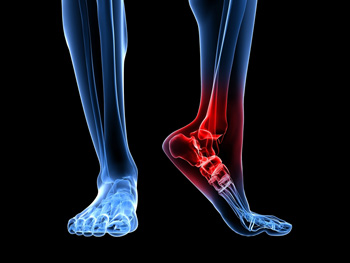 Heel pain can vary in severity and type. Since the heel is the first part of the foot to make contact with the ground, it absorbs the full force of impact and bears the most weight while walking. One of the most common causes of heel pain is plantar fasciitis. This occurs when the ligament that attaches the heel to the ball of the foot, known as the plantar fascia, becomes irritated. Heel spurs, which are bone growths at the bottom of the heel, can also cause heel pain. Other issues that can cause heel pain include repetitive stress or shock to the heel, standing for too long, or osteoarthritis. If you are experiencing heel pain, it is important to consult with a podiatrist to help diagnose and treat the painful condition.
Heel pain can vary in severity and type. Since the heel is the first part of the foot to make contact with the ground, it absorbs the full force of impact and bears the most weight while walking. One of the most common causes of heel pain is plantar fasciitis. This occurs when the ligament that attaches the heel to the ball of the foot, known as the plantar fascia, becomes irritated. Heel spurs, which are bone growths at the bottom of the heel, can also cause heel pain. Other issues that can cause heel pain include repetitive stress or shock to the heel, standing for too long, or osteoarthritis. If you are experiencing heel pain, it is important to consult with a podiatrist to help diagnose and treat the painful condition.
Many people suffer from bouts of heel pain. For more information, contact Dr. Dean D. Hinners of Illinois. Our doctor can provide the care you need to keep you pain-free and on your feet.
Causes of Heel Pain
Heel pain is often associated with plantar fasciitis. The plantar fascia is a band of tissues that extends along the bottom of the foot. A rip or tear in this ligament can cause inflammation of the tissue.
Achilles tendonitis is another cause of heel pain. Inflammation of the Achilles tendon will cause pain from fractures and muscle tearing. Lack of flexibility is also another symptom.
Heel spurs are another cause of pain. When the tissues of the plantar fascia undergo a great deal of stress, it can lead to ligament separation from the heel bone, causing heel spurs.
Why Might Heel Pain Occur?
- Wearing ill-fitting shoes
- Wearing non-supportive shoes
- Weight change
- Excessive running
Treatments
Heel pain should be treated as soon as possible for immediate results. Keeping your feet in a stress-free environment will help. If you suffer from Achilles tendonitis or plantar fasciitis, applying ice will reduce the swelling. Stretching before an exercise like running will help the muscles. Using all these tips will help make heel pain a condition of the past.
If you have any questions please contact one of our offices located in Metropolis and Eldorado, IL . We offer the newest diagnostic and treatment technologies for all your foot and ankle needs.
Foot Stretches May Prevent Muscle Cramps
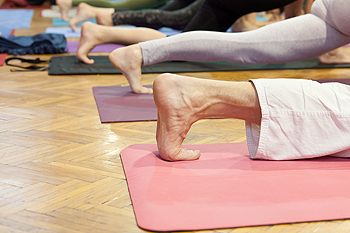 There are specific stretches that can be performed which can benefit the feet and ankles. Calf stretches are helpful in stretching the Achilles tendon, which is located at the back of the leg. Its purpose is to connect the heel to the calf muscles, and stretching this tendon will help to keep it flexible. This can be accomplished by standing on a step, and gently lowering one heel at a time. The top of the foot can be strengthened by picking up marbles with the toes, and slowly releasing them. Performing a towel pull is an effective stretch to keep the overall foot strong. This is done by sitting down with your legs in front of you, putting a towel across the bottom of your feet, and pulling it toward you. When the proper foot stretches are frequently practiced, muscle cramps may possibly be prevented. If you would like additional information about stretching exercises for the feet, please consult with a podiatrist.
There are specific stretches that can be performed which can benefit the feet and ankles. Calf stretches are helpful in stretching the Achilles tendon, which is located at the back of the leg. Its purpose is to connect the heel to the calf muscles, and stretching this tendon will help to keep it flexible. This can be accomplished by standing on a step, and gently lowering one heel at a time. The top of the foot can be strengthened by picking up marbles with the toes, and slowly releasing them. Performing a towel pull is an effective stretch to keep the overall foot strong. This is done by sitting down with your legs in front of you, putting a towel across the bottom of your feet, and pulling it toward you. When the proper foot stretches are frequently practiced, muscle cramps may possibly be prevented. If you would like additional information about stretching exercises for the feet, please consult with a podiatrist.
Stretching the feet is a great way to prevent injuries. If you have any concerns with your feet consult with Dr. Dean D. Hinners from Illinois. Our doctor will assess your condition and provide you with quality foot and ankle treatment.
Stretching the Feet
Being the backbone of the body, the feet carry your entire weight and can easily become overexerted, causing cramps and pain. As with any body part, stretching your feet can serve many benefits. From increasing flexibility to even providing some pain relief, be sure to give your feet a stretch from time to time. This is especially important for athletes or anyone performing aerobic exercises, but anyone experiencing foot pain or is on their feet constantly should also engage in this practice.
Great ways to stretch your feet:
- Crossing one leg over the others and carefully pull your toes back. Do 10-20 repetitions and repeat the process for each foot
- Face a wall with your arms out and hands flat against the wall. Step back with one foot and keep it flat on the floor while moving the other leg forward. Lean towards the wall until you feel a stretch. Hold for 30 seconds and perform 10 repetitions for each foot
- Be sure not to overextend or push your limbs too hard or you could risk pulling or straining your muscle
Individuals who tend to their feet by regular stretching every day should be able to minimize foot pain and prevent new problems from arising.
If you have any questions, please feel free to contact one of our offices located in Metropolis and Eldorado, IL . We offer the newest diagnostic and treatment technologies for all your foot care needs.

